
Ants are eusocial insects of the family Formicidae and, along with the related wasps and bees, belong to the order Hymenoptera. Ants evolved from vespoid wasp ancestors in the Cretaceous period. More than 13,800 of an estimated total of 22,000 species have been classified. They are easily identified by their geniculate (elbowed) antennae and the distinctive node-like structure that forms their slender waists.

Paraponera clavata, commonly known as the bullet ant, is a species of ant named for its extremely painful sting. It inhabits humid lowland rainforests in Central and South America.
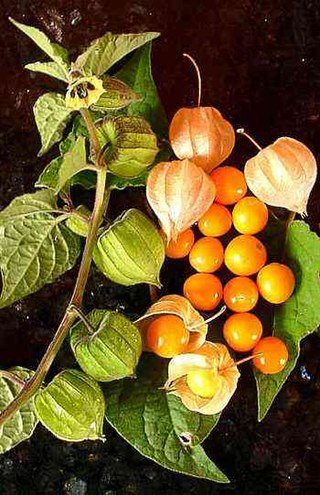
Physalis peruviana is a species of plant in the nightshade family (Solanaceae) native to Chile and Peru. Within that region it is called aguaymanto, uvilla or uchuva, in addition to numerous indigenous and regional names. In English, its common names include Cape gooseberry, goldenberry and Peruvian groundcherry.

The red-crowned ant tanager is a medium-sized passerine bird from tropical America. The genus Habia was long placed with the tanagers (Thraupidae), but it is actually closer to the cardinals (Cardinalidae). Consequently, it can be argued that referring to the members of this genus as ant-tanagers is misleading, but no other common name has gained usage.

Scilla peruviana, the Portuguese squill, is a species of Scilla native to the western Mediterranean region in Iberia, Italy, and northwest Africa. It is a bulb-bearing herbaceous perennial plant. The bulb is 6–8 cm in diameter, white with a covering of brown scales. The leaves are linear, 20–60 cm long and 1–4 cm broad, with 5-15 leaves produced each spring. The flowering stem is 15–40 cm tall, bearing a dense pyramidal raceme of 40-100 flowers; each flower is blue, 1–2 cm in diameter, with six tepals. The foliage dies down in summer, re-appearing in the autumn.

Fulakora saundersi, commonly known as "The New Zealand Michelin Ant", is a species of ant within the family Formicidae in the genus Fulakora, found throughout New Zealand.
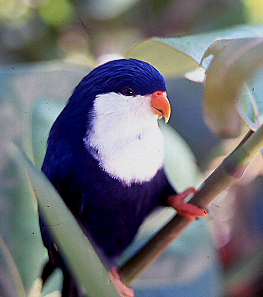
The blue lorikeet is a small lorikeet from French Polynesia and the Cook Islands. It is also known as the Tahiti lorikeet, violet lorikeet, Tahitian lory, blue lory, nunbird, and the indigo lory. It was formerly found on 23 islands around Tahiti, but now restricted to perhaps eight islands: Aitutaki, Apataki, Arutua, Kaukura, Manuae, Maupihaa, Motu One, Rangiroa, and possibly Manihi and Manuae. Its plumage is mainly dark blue and it has a white area over its upper chest, throat and face. The first captive breeding in the UK was by the Marquess of Tavistock in the 1930s. He was awarded a silver medal by the Foreign Bird League for this achievement.

Noblella peruviana is a species of frog in the family Strabomantidae. It is endemic to the Andean highlands in Peru.

The coastal miner is a species of bird in the subfamily Sclerurinae, the leaftossers and miners, of the ovenbird family Furnariidae. It is endemic to Peru.

The Christmas Island shrew, also known as the Christmas Island musk-shrew is an extremely rare or possibly extinct shrew from Christmas Island. It was variously placed as subspecies of the Asian gray shrew or the Southeast Asian shrew, but morphological differences and the large distance between the species indicate that it is an entirely distinct species.

The rose-fronted parakeet, known as the rose-fronted conure in aviculture, is a species of bird in the subfamily Arinae of the family Psittacidae, the African and New World parrots. It is found in Bolivia, Brazil, Ecuador, and Peru.
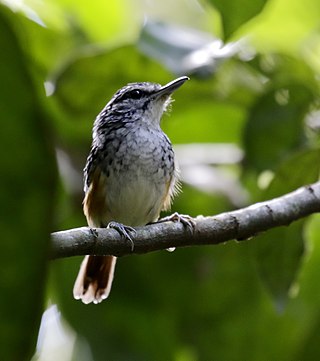
The Peruvian warbling antbird is a species of bird in the family Thamnophilidae. It was considered a subspecies of Hypocnemis cantator, but based on vocal differences and to a lesser degree differences in plumages, it has been recommended that they be treated as separate species. As presently defined, the Peruvian warbling antbird includes a single subspecies, saturata. It has a black, white, and grey head and breast, with rufous flanks and a dull brown lower back and tail.
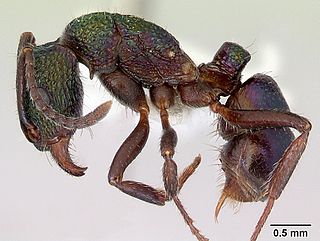
Rhytidoponera is a large genus of ants in the subfamily Ectatomminae. The genus is known from Australia and Melanesia, with New Caledonia as the most eastern limit.
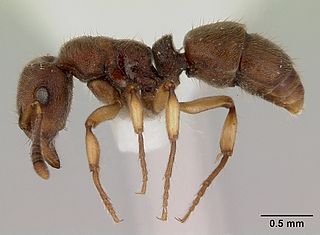
Heteroponerinae is a subfamily of ants in the poneromorph subfamilies group containing three genera in one tribe. The subfamily was created in 2003 when Barry Bolton divided the Ponerinae subfamily into six subfamilies.

Heteroponera is a genus of ants in the subfamily Heteroponerinae. The genus is known from the Neotropics and Australasia.

Acanthoponera is a Neotropical genus of ants in the subfamily Heteroponerinae. Acanthoponera contains six rarely collected species and a fifth unnamed species mentioned by Brown (1958) only known from a stray gyne.
Acanthoponera goeldii is a species of ant belonging to the genus Acanthoponera. Described in 1912 by Forel, the species is native to North America and South America.

Acanthoponera minor is a species of ant belonging to the genus Acanthoponera. Described in 1899 by Forel, the species is native to North America, Central America and South America.
















